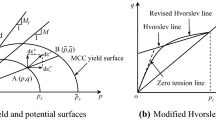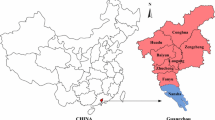Abstract
For the excavation of a shallow tunnel in soft soil, the controllable range of the support pressure is narrow due to the small area of overburdened earth pressure, and passive failure of the tunnel face can be easily induced; therefore, the soft soil must be reinforced to increase the stability of the tunnel face. In this work, numerical simulation and theoretical analysis were adopted to explore the passive failure mechanism of a tunnel face in soft ground reinforced with a soil–cement wall. First, finite element analyses were conducted to investigate the passive failure mechanism. The impact of L1 (the distance between the tunnel face and soil–cement wall) on the passive failure mode was disclosed. Three types of failure modes—the full-penetration, partial-penetration, and non-penetration modes—were identified based on the shear failure zone and variation in Pp (the limit support pressure of passive failure) with L1. Then, analytical models based on the limit equilibrium method for the three passive failure modes were established, and formulas for predicting Pp were derived. The predictions by the formulas were validated by the numerical results, and their differences were within 10%. Both indicate that Pp achieved a maximum value when L1 = 0.2D (D is the diameter of tunnel); therefore, it is reasonable to choose a distance of 0.2D between cement walls in this engineering project.
















Similar content being viewed by others
References
Anagnostou G (2012) The contribution of horizontal arching to tunnel face stability. Geotechnik 35(1):34–44. https://doi.org/10.1002/gete.201100024
Alagha AS, Chapman DN (2019) Numerical modelling of tunnel face stability in homogeneous and layered soft ground. Tunn Undergr Space Technol 94:103096. https://doi.org/10.1016/j.tust.2019.103096
Bolton MD (1986) The strength and dilatancy of sands. Geotechnique 36:65–78. https://doi.org/10.1680/geot.1986.36.1.65
Brinkgreve RBJ, Swolfs WM, Engin E (2011) PLAXIS 3D 2011 user manual. Plaxis BV, Delft, The Netherlands
Chen WF (2007) Limit analysis and soil plasticity. J. Ross Publishing
Chen RP, Li J, Kong L, Tang LJ (2013) Experimental study on face instability of shield tunnel in sand. Tunn Undergr Space Technol 33:12–21. https://doi.org/10.1016/j.tust.2012.08.001
Chen RP, Tang LJ, Yin XS, Chen YM, Bian XC (2015) An improved 3D wedge-prism model for the face stability analysis of the shield tunnel in cohesionless soils. Acta Geotech 10(5):683–692. https://doi.org/10.1007/s11440-014-0304-5
Chen RP, Yin X, Tang L, Chen Y (2018) Centrifugal model tests on face failure of earth pressure balance shield induced by steady state seepage in saturated sandy silt ground. Tunn Undergr Space Technol 81:315–325. https://doi.org/10.1016/j.tust.2018.06.031
Das BM (2021) Principles of geotechnical engineering. Cengage learning
Fu Y, He S, Zhang S, Yang Y (2020) Parameter analysis on hardening soil model of soft soil for foundation pits based on shear rates in Shenzhen Bay, China. Adv Mater Sci Eng. https://doi.org/10.1155/2020/7810918
Gu XQ, Hu J, Huang MS (2015) K0 of granular soils: a particulate approach. Granul Matter 17(6):703–715. https://doi.org/10.1007/s10035-015-0588-7
Hernández YZ, Farfán AD, de Assis AP (2019) Three-dimensional analysis of excavation face stability of shallow tunnels. Tunn Undergr Space Technol 92:103062. https://doi.org/10.1016/j.tust.2019.103062
Han K, Wang L, Su D, Hong C, Chen X, Lin XT (2021) An analytical model for face stability of tunnels traversing the fault fracture zone with high hydraulic pressure. Comput Geotech 140:104467. https://doi.org/10.1016/j.compgeo.2021.104467
Huang M, Li Y, Shi Z, Lü X (2022) Face stability analysis of shallow shield tunneling in layered ground under seepage flow. Tunn Undergr Space Technol 119:104201. https://doi.org/10.1016/j.tust.2021.104201
Idinger G, Aklik P, Wu W, Borja RI (2011) Centrifuge model test on the face stability of shallow tunnel. Acta Geotech 6(4):105–117
Ibrahim E, Soubra AH, Mollon G, Raphael W, Dias D, Reda A (2015) Three-dimensional face stability analysis of pressurized tunnels driven in a multilayered purely frictional medium. Tunn Undergr Space Technol 49:18–34. https://doi.org/10.1016/j.tust.2015.04.001
Jallow A, Ou CY, Lim A (2019) Three-dimensional numerical study of long-term settlement induced in shield tunneling. Tunn Undergr Space Technol 88:221–236. https://doi.org/10.1016/j.trgeo.2020.100467
Kirsch A (2010) Experimental investigation of the face stability of shallow tunnels in sand. Acta Geotech 5(1):43–62
Leca E, Dormieux L (1990) Upper and lower bound solutions for the face stability of shallow circula tunnels in frictional material. Geotechnique 40:581–606. https://doi.org/10.1680/geot.1990.40.4.581
Li Y, Emeriault F, Kastner R, Zhang ZX (2009) Stability analysis of large slurry shield-driven tunnel in soft clay. Tunn Undergr Space Technol 24(4):472–481. https://doi.org/10.1016/j.tust.2008.10.007
Lü X, Zhou Y, Huang M, Zeng S (2018) Experimental study of the face stability of shield tunnel in sands under seepage condition. Tunn Undergr Space Technol 74:195–205. https://doi.org/10.1016/j.tust.2018.01.015
Li P, Chen K, Wang F, Li Z (2019) An upper-bound analytical model of blow-out for a shallow tunnel in sand considering the partial failure within the face. Tunn Undergr Space Technol 91:102989. https://doi.org/10.1016/j.tust.2019.05.019
Liu W, Zhao Y, Shi PX, Li JY, Gan PL (2017) Face stability analysis of shield-driven tunnels shallowly buried in dry sand using 1-g large-scale model tests. Acta Geotech 13(3):693–705
Liu W, Shi P, Chen L, Tang Q (2020) Analytical analysis of working face passive stability during shield tunneling in frictional soils. Acta Geotech 15(3):781–794. https://doi.org/10.1007/s11440-018-0753-3
Li D, Zhao L, Cheng X, Zuo S, Jiao K (2020) Upper-bound limit analysis of passive failure of a 3D shallow tunnel face under the bidirectional inclined ground surfaces. Comput Geotech 118:103310. https://doi.org/10.1016/j.compgeo.2019.103310
Li P, Wei Y, Zhang M, Huang Q, Wang F (2022) Influence of non-associated flow rule on passive face instability for shallow shield tunnels. Tunn Undergr Space Technol 119:104202. https://doi.org/10.1016/j.tust.2021.104202
Mollon G, Dias D, Soubra AH (2011) Rotational failure mechanisms for the face stability analysis of tunnels driven by a pressurized shield. Int J Numer Anal Meth Geomech 35(12):1363–1388. https://doi.org/10.1002/nag.962
Mollon G, Dias D, Soubra AH (2013) Continuous velocity fields for collapse and blowout of a pressurized tunnel face in purely cohesive soil. Int J Numer Anal Methods Geomech 37(13):2061–2083. https://doi.org/10.1002/nag.2121
Mu L, Huang M (2016) Small strain based method for predicting three-dimensional soil displacements induced by braced excavation. Tunn Undergr Space Technol 52:12–22. https://doi.org/10.1016/j.tust.2015.11.001
Ng CWW, Wong KS (2013) Investigation of passive failure and deformation mechanisms due to tunnelling in clay. Can Geotech J 50(4):359–372. https://doi.org/10.1139/cgj-2012-0098
O’Rourke TD, McGinn AJ (2006) Lessons learned for ground movements and soil stabilization from the Boston Central Artery. J Geotech Geoenviron Eng 132(8):966–989. https://doi.org/10.1061/(ASCE)1090-0241(2006)132:8(966)
Pellegrino G, Bruce DA (1996) Jet grouting for the solution of tunneling problems in soft clays. In: Grouting and deep mixing, pp 347–352
Paternesi A, Schweiger HF, Scarpelli G (2017) Numerical analyses of stability and deformation behavior of reinforced and unreinforced tunnel faces. Comput Geotech 88:256–266. https://doi.org/10.1016/j.compgeo.2017.04.002
Soubra A, Dias D, Emeriault F, Kastner R (2008) Three-dimensional face stability analysis of circular tunnels by a kinematical approach. In: GeoCongress 2008, pp 894–901
Schmüdderich C, Shahrabi MM, Taiebat M, Lavasan AA (2020) Strategies for numerical simulation of cast-in-place piles under axial loading. Comput Geotech 125:103656. https://doi.org/10.1016/j.compgeo.2020.103656
Tyagi A, Zulkefli MFB, Pan Y, Goh SH, Lee FH (2017) Failure modes of tunnels with improved soil surrounds. J Geotech Geoenviron Eng 143(11):04017088. https://doi.org/10.1061/(ASCE)GT.1943-5606.0001788
Tyagi A, Liu Y, Pan YT, Lee FH (2020) Equivalent strength for tunnels in cement-admixed soil columns with spatial variability and positioning error. J Geotech Geoenviron Eng 146(10):04020101. https://doi.org/10.1061/(ASCE)GT.1943-5606.0002351
Tanoli AY, Yan B, Xiong YL, Ye GL, Khalid U, Xu ZH (2022) Numerical analysis on zone-divided deep excavation in soft clays using a new small strain elasto–plastic constitutive model. Underground Space 7(1):19–36. https://doi.org/10.1016/j.undsp.2021.04.004
Ukritchon B, Keawsawasvong S, Yingchaloenkitkhajorn K (2017) Undrained face stability of tunnels in Bangkok subsoils. Int J Geotech Eng 11(3):262–277. https://doi.org/10.1080/19386362.2016.1214773
Wong KS, Ng CWW, Chen YM, Bian XC (2012) Centrifuge and numerical investigation of passive failure of tunnel face in sand. Tunn Undergr Space Technol 28:297–303. https://doi.org/10.1016/j.tust.2011.12.004
Wang Y, Zhang S, Niu D, Su L, Luo D (2020) Strength and chloride ion distribution brought by aggregate of basalt fiber reinforced coral aggregate concrete. Constr Build Mater 234:117390. https://doi.org/10.1016/j.conbuildmat.2019.117390
Xu Q, Zhu H, Ma X, Ma Z, Li X, Tang Z, Zhuo K (2015) A case history of shield tunnel crossing through group pile foundation of a road bridge with pile underpinning technologies in Shanghai. Tunn Undergr Space Technol 45:20–33. https://doi.org/10.1016/j.tust.2014.09.002
Yang J, Gu XQ (2013) Shear stiffness of granular material at small strains: does it depend on grain size? Géotechnique 63(2):165–179. https://doi.org/10.1680/geot.11.P.083
Yu L, Zhang D, Fan Q, Cao L, Zhang Y, Xu T (2020) Face stability of shallow tunnelling in sandy soil considering unsupported length. Tunn Undergr Space Technol 102:103445. https://doi.org/10.1016/j.tust.2020.103445
Yin X, Chen R, Meng F, Ding Z, Cui Y, Hedayat A, Mooney M (2021) Face stability of slurry-driven shield with permeable filter cake. Tunn Undergr Space Technol 111:103841. https://doi.org/10.1016/j.tust.2021.103841
Yin X, Chen R, Meng F (2021) Influence of seepage and tunnel face opening on face support pressure of EPB shield. Comput Geotech 135:104198. https://doi.org/10.1016/j.compgeo.2021.104198
Zhang C, Han K, Zhang D (2015) Face stability analysis of shallow circular tunnels in cohesive–frictional soils. Tunn Undergr Space Technol 50:345–357. https://doi.org/10.1016/j.tust.2015.08.007
Zheng G, Yang X, Zhou H, Du Y, Sun J, Yu X (2018) A simplified prediction method for evaluating tunnel displacement induced by laterally adjacent excavations. Comput Geotech 95:119–128. https://doi.org/10.1016/j.compgeo.2017.10.006
Zhang Z, Shi X, Wang B, Li H (2018) Stability of NATM tunnel faces in soft surrounding rocks. Comput Geotech 96:90–102. https://doi.org/10.1016/j.compgeo.2017.10.009
Zhang X, Wang M, Wang Z, Li J, Tong J, Liu D (2020) A limit equilibrium model for the reinforced face stability analysis of a shallow tunnel in cohesive-frictional soils. Tunn Undergr Space Technol 105:103562. https://doi.org/10.1016/j.tust.2020.103562
Acknowledgements
This work was financially supported by the Chinese Natural Science Foundation (Nos. 51938008 and 52090081), the Natural Science Foundation of Shenzhen under Grant No. JCYJ20210324094607020, the National Natural Science Foundation of China (Project No. 52108388), and the science and technology innovation Program of Hunan Province (Project No. 2021RC3015 and 2022JJ40611).
Author information
Authors and Affiliations
Corresponding author
Additional information
Publisher's Note
Springer Nature remains neutral with regard to jurisdictional claims in published maps and institutional affiliations.
Rights and permissions
Springer Nature or its licensor (e.g. a society or other partner) holds exclusive rights to this article under a publishing agreement with the author(s) or other rightsholder(s); author self-archiving of the accepted manuscript version of this article is solely governed by the terms of such publishing agreement and applicable law.
About this article
Cite this article
Song, Q., Su, D., Pan, Q. et al. Limit equilibrium models for passive failure of a large-diameter shield tunnel face in reinforced soft clay. Acta Geotech. (2024). https://doi.org/10.1007/s11440-024-02238-7
Received:
Accepted:
Published:
DOI: https://doi.org/10.1007/s11440-024-02238-7




